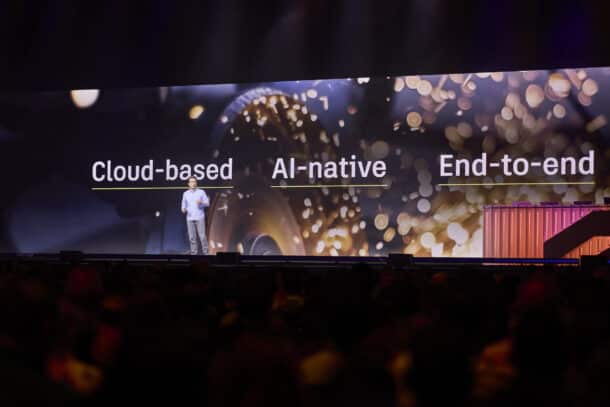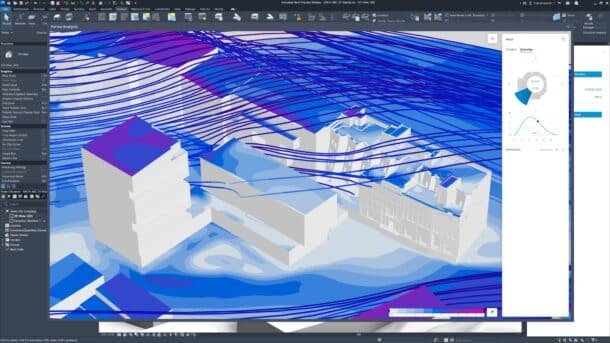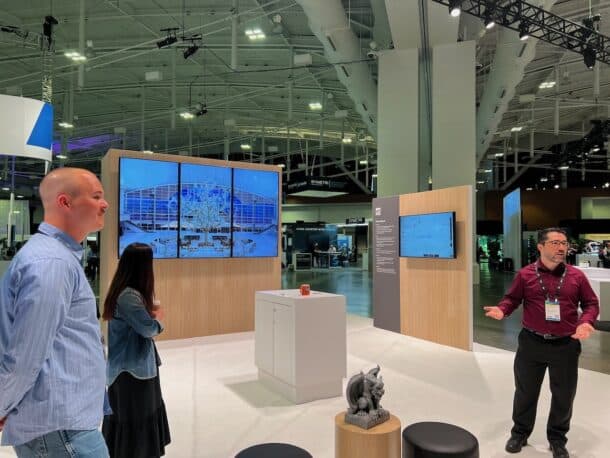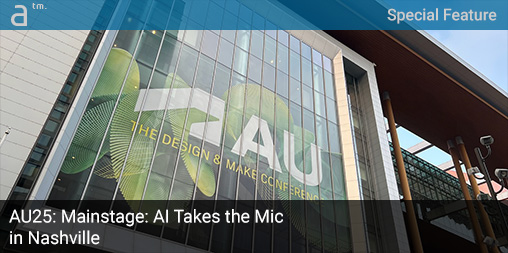AI CONCEPTS HAVE BECOME A TANGIBLE REALITY. Autodesk is rolling out its first generation of Neural CAD engines and weaving AI deeply into Forma, its cloud-based AEC platform. These new capabilities promise to transform how architects, engineers, and planners explore options, automate workflows, and collaborate across disciplines.
MORE: AU25: All About Autodesk’s AI Neural CAD Engines
In this feature article, we will conclude our coverage by tying it to our previous AU25 reports, while deepening our technical information and broadening our industry perspective. While the California-headquartered company has many announcements, we will focus intently on the AEC/O industry implications of Autodesk’s cloud and AI initiatives. After all, these have great potential to transform how Autodesk customers work on their projects.
Before we delve into the AI technologies at AU25, let’s recap the Forma story, as it’s crucial for several reasons.
The Future is Forma
In the past, AU’s attendees heard promises of the future around Forma. This year, Autodesk delivered both new Forma products and cloud consolidation all under the Forma brand. Now, cloud visions for AEC/O are becoming more tangible in the Autodesk world, and everything runs through Forma (or will soon enough).

Autodesk President and CEO Andrew Anagnost on stage on Day One at AU25, discussing the end-to-end cloud-based AI-native technologies that are transforming Autodesk solutions for industries like AEC and D&M. (Image: Autodesk).
As we wrote in this report (see: Architosh, “AU25: What’s New in the Forma AECO Industry Cloud,” 18 Sep 2025), Autodesk Construction Cloud (ACC) is now getting tucked into the Forma cloud. This is all part of the effort to unify a cloud-based environment for planning, designing, and building and operations professionals.
The CDE Story
This even impacts the naming of older products. Autodesk Docs, the company’s common data environment (CDE) for AEC/O, is now officially Forma Data Management. This constant habit of renaming products is confusing, and CEO Andrew Anagnost even acknowledged that on stage in Nashville. But the company aims to get things cleaner and straighter under a grand Forma umbrella. With Forma Data Management, Autodesk’s renamed CDE, information is expected to flow across all phases of the project’s lifecycle and from tool to tool, including cloud to desktop.
In our previous report (see: Architosh, “AU25: Autodesk Introduces Forma Building Design,” 16 Sep 2025), we noted that Revit is to be the first “Forma Connected Client” as part of the push to connect Autodesk’s legacy desktop AEC solutions to the Forma industry cloud. The goal is simple: customer design data can move freely between solutions in the Forma cloud and desktop solutions, while features and capabilities of the Forma cloud can be piped into desktop solutions that are Forma Connected Clients. (see image below).

Forma’s environmental analysis tools seen here inside Autodesk Revit. Amy Bunzel, EVP, Architecture, Engineering, and Construction Solutions, told a small AEC-centric media group that there are two ways this happens. One way is through a web-browser like viewport inside the Forma Connected Client, the other way is the capabilities themselves, their logic or computational functions can be API-connected into the Forma Connected Client. Bunszel said both will happen. (Image: Autodesk)
While Autodesk rebrands its products and introduces cloud tools, AI technologies, and data flow strategies, its loyal customers adjust, adapt, and move with them. But they are not just moving, they are leveraging the benefits that come with a connected cloud digital ecosystem. The expansion of the Denver International Airport is just one example of a customer story where the end-user (DEN, locals refer to it as DIA) acknowledged that the cloud was vital to their project’s success, and without it, the project would have taken longer and cost much more.
Vision 100: DEN
Vision 100 is the project name for the expansion of Denver International Airport, which will increase DEN’s capacity from its original 50 million passengers to 100 million. DEN is the 6th most busy international airport in the world and presently serves 82.3 million passengers, far beyond its ideal physical limits, thus the Vision 100 project.

Exemplar Autodesk customer product, the terminal expansion at Denver International Airport (DEN). (Image: Autodesk)
At AU25, the media had the opportunity to listen to Brendan Dillon, Director of Digital Facilities and Infrastructure at Denver International Airport, discuss the project’s scope, complexity, and challenges, as well as how Autodesk AEC software was utilized to execute the project.

Brendan Dillon, Director of Digital Facilities and Infrastructure at Denver International Airport, discusses the Vision 100 project which will bring up the capacity of DEN to 100 million passengers served annually. This was the first project where the airport used Autodesk Construction Cloud (ACC). (Image: Architosh)
The Vision 100 expansion project was the first time DEN used Autodesk Construction Cloud (ACC), now integrated into the Forma cloud. Brendon Dillon said that at any given time, they were working with more than 100 contractors and thousands of workers. Brendan’s team uses AutoCAD, Revit, and Autodesk Civil3D as their core design software.
Tandem Digital Twin
They also utilized the digital twin software Autodesk Tandem to consolidate all of their facilities’ BIM models, including the new terminal expansion. An infographic at AU25 for the Vision 100 project noted that nearly 500 RVT models were utilized for the project. Brendon Dillon says that airports are laboratories for testing the latest digital technologies due to their size and complexity. The Vision 100 project story is also told via this video interview here.
AI Takes the Mic in Nashville
It would be an understatement to say AI stole the show in Nashville this September. Autodesk is making massive claims about the potential productivity gains that can come via AI. But this wasn’t all talk and those in attendance witnessed both Autodesk Assistant (aka: AA), a text-prompt-based tool shown working inside Autodesk Revit and other tools, as well as the even bigger news about the new Neural CAD engines, which are also called AI foundation models.

A critical piece of the AI revolution are MCP Servers and they are dynamic drivers of the AI revolution. Their emergence in 2024 are a milestone for AI technologies. We discuss them in detail below.
We have broken down the Neural CAD engines in another report but the takeaway is this: traditional CAD engines are being programmatically altered so that an AI layer can generatively produce 3D CAD model data that can be edited later by common human CAD interactions.
MORE: AU25: All about Autodesk’s AI Neural CAD Engines
When I asked Autodesk staff if the Neural CAD engines were entirely new versus utilizing a next evolution of their own proprietary geometric modeling kernel, ShapeManager, which was originally forked from the ACIS kernel back in 2001, they didn’t quite answer me in the clearest of terms, but what was clear is that after generative-AI based model generation, these models were further editable inside Autodesk’s other existing tools—Fusion and Forma or Revit. To be more explicit. Via text prompt, the neural CAD engine generates 3D objects in the form of a boundary representation (BREP) geometry and this can be edited within Fusion. A similar thing is happening in Forma Building Designer but it is not a BREP. (see below)

All these generative AI models were produced using Autodesk’s new Neural CAD engines. Via text prompts, various 3D models can be generated by the new neural CAD engines and the resultant models are fully editable in Autodesk Fusion, the company’s leading cloud-based CAD tool for design and manufacturing (D&M) customers. (Image: Architosh).
In my test experience on the show floor, the neural CAD engine for geometry generated a series of electric toothbrushes. All of this from a text prompt, but the neural CAD engines can also understand hand drawings and photos.
With neural CAD for buildings, the text prompts are communicating to an AI foundation model that has been trained on building design and thus understands things like corridors, rooms, walls, doors, windows and so forth. It also understands spatial and physical relationships and structural systems. So you can tell Forma Building Design to create an all concrete design or a steel one or some other system.
A conceptual demo of the advanced agentic AI that Autodesk is imagining and developing for the future of AEC professionals, as shown at AU25 in Nashville. They have created key building blocks for this kind of AI workflow.
The new Building Layout Explorer is the name for the neural CAD engine technologies powering the upcoming Forma Building Design. In a media only session on the show floor, we were able to see the AI engine generate a single-loaded corridor design and then the user can lock down specific aspects of the generative design while iterating more with the AI agent.
MCP Servers
Autodesk noted that MCP servers are taking AI to the next level. MCP refers to Model Context Protocol and the AI technology is developed and open-sourced by Anthropic and is being touted as an industry AI standard. This technology enables AI agents and large language models (LLMs) to connect with external software tools (apps via APIs), data sources, and services.

Autodesk Assistant is Agentic AI in action. “AA,” as it is called, can surface your data without being prompted and provide predictive insights. It can also automate repetitive tasks in tools like Revit shown here. (Image: Autodesk)
Some have said that MCP is the “USB-C port for AI” meaning it connects to things that can have real-time data in them. Unlike earlier ChatGPT type AI chatbots, MCP servers enable AI agents to access real-world context and capabilities and not just a static set of training data, like in the earlier versions of ChatGPT.
MORE: Introducing the Model Context Protocol
The capabilities can include the ability to control and execute software functions in existing software solutions. This has been recently demonstrated by other AEC software companies. Model Context Protocol is about communication and frees up AI agents from being trapped behind static training data. In the case of Autodesk Assistant (AA), via Autodesk’s MCP servers, AA will have access to other third party AI agents, APIs from Autodesk apps, data lakes (data sources), and services.
The API Story
Amy Bunszel said in our smaller AEC media meeting that API calls were already up 43 percent from a year ago and this is all before these new Autodesk MCP servers are available to their users. What Bunszel was getting at in our private meeting was the fact that data exchange connectors “between Autodesk products and non-Autodesk products are in high demand.”
To fix interop we need to fix data before we even get to AI.
Autodesk believes that interoperability and automation are crucial for Autodesk’s AI future vision. “Interop is the backbone” the company says and work should flow fluidly with no wasted hours or difficult hand-offs. That’s easier said than done, and today construction pros lose up to six (6) hours per week due to this. Autodesk execs said that “to fix interop we need to fix data before we even get to AI.”
Geometry Mapping
Bunszel thus laid out the mandate of what the company and the industry need to do. They need to fix data first to optimally address interoperability. Native geometry mapping is a crucial step so that geometry model data from different applications to move between applications, including third-party applications outside of Autodesk’s many tools. This is so critical that even big customers like Ramboll, for example, is one such large global engineering company writing their own geometry mapping APIs to move model data between various software tools from different vendors.
The Cost of Advanced AI
With demand for better interop and a growing hunger for AI-powered tools in AEC workflows, a natural question that arrises is the cost of token usage for inference. As users begin to embrace tools like Autodesk Forma Building Design and iterate with generative AI, plus tap the power and usefulness of AI agents like Autodesk Assistant (AA), demand for inference will skyrocket at AI data centers. So how is this cost going to be accounted for?

Readers need to understand that we are only in the nascent stages of the AI industrial revolution. Specifically, the way computer users today work with AI tools is mostly with AI agents like Google’s Gemini (widely used now as part of Google search, and Chatbot tools like OpenAI’s ChatGPT or Anthropic’s Claude or Perplexity.AI. These tools plus visual AI tools like Midjourney and Stable Diffusion and onward with more specific AI image generators like Chaos Veras and Nemetschek’s AI Visualizer represent the bottom tier of the AI era pyramid. What comes next is Autodesk largely showcased at AU25 in Nashville, with its Neural CAD engines running new tools like Forma Building Design which represents the next level up with spatial and physical reasoning and some basic industry-specific reasoning. (Image: Architosh)
Amy Bunszel said the company’s subscription-based software licensing models will need to be augmented with usage-based licensing models. That sounds simple in theory but every software vendor in the market (not just the AEC market) who brings generative and agentic AI tools into powerful utilization will see customers thirst for such capabilities skyrocket. If the AI workflows are as transformative as witnessed at AU25, wouldn’t customers adopt and embrace them at accelerating rates?
The good news is Autodesk and the rest of the AEC/O market have time to figure this question out. AI features will be rolled out slowly and at varying rates depending on the specifics of that AI technology. The big takeaway from AU25 in Nashville isn’t just that AI took the mic but that we are now seeing actual AI solutions arriving in today’s most popular Autodesk AEC tools.



